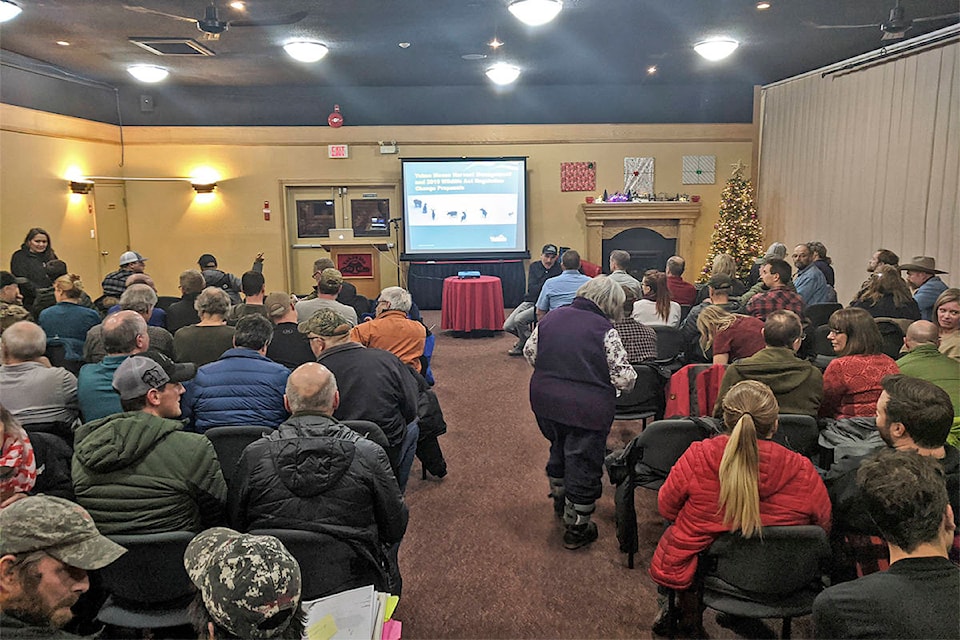A public meeting about proposed regulation changes to the Yukon’s Wildlife Act brought about a hundred people to Whitehorse’s Yukon Inn the evening of Dec. 11, many of them armed with questions and criticisms.
Hosted by the Yukon Fish and Wildlife Management Board, the meeting was the last of five that have been held in recent weeks across the territory.
This year’s proposed regulations have drawn more attention than usual; the board received 550 submissions during its online survey period, compared to an average of around 150.
Among the 14 proposals are four related to moose harvest management, one that could see the creation of a new caribou hunting opportunity, one that could further limit burbot catch and possession limits and a prohibition on roadside trophy hunting of grizzly bears in the Southern Lakes region.
Each was discussed in varying levels of detail, with board members and Yukon government staff and biologists on hand to answer questions.
The board was set to deliberate on the majority of the proposals Dec. 12 and deliver its recommendations to the Yukon’s environment minister thereafter.
Board chair John Burdek, however, announced early on that the public input period for three of the moose proposals — one that would allow the Yukon government to take an “adaptive management” approach overall, two that could potentially restrict harvest in the South Canol and Sifton-Miners Mountain areas — had been extended by 90 days, to the audible approval of several attendees.
Burdek said in an interview afterwards that it was “obvious” based on feedback received from the online survey that there needed to be more time for discussion and education around the moose proposals. He said the board didn’t hear the same concerns around timing for the others.
Still, the moose proposals took up approximately a third of the three-and-a-half-hour-long meeting, with the discussion occasionally veering towards venting or finger-pointing.
Several attendees did not appear to understand the authority of the Umbrella Final Agreement or final agreements and the harvesting rights entrenched in them, questioning why First Nations may continue to harvest while licenced hunters face restrictions.
Many of the same people argued that hunting restrictions, whether they be closures, restrictions on the use of off-road vehicles or reduced harvest quotas, should be applied “across the board.”
Another major point of contention was the data, or what some attendees thought was the lack thereof, to justify the implementation of some of the proposals.
One of the most contentious was the proposed reduction on burbot catch and possession limits, with a man, at one point, heatedly asking a Yukon government biologist for the exact number of burbot in several lakes in the the territory.
The Yukon government is proposing to bring catch and possession from 10/20 to 3/6 after a survey of seven lakes showed burbot populations at significantly lower levels than anticipated.
Philip Merchant, a former Environment Yukon employee, told the News that management decisions need to be science-based. He said he fishes burbot on Lake Laberge, which was not one of the seven lakes surveyed. He also said there are significant gaps when it comes to moose harvest data — in particular, First Nations harvest — that need to be filled in before changes are made.
“It’s unfortunate that some young biologist or somebody has to get roasted but at the same time, you need to come with your A-game to a meeting, you need to have the data,” he said.
“… There’s a lot of smart people in the room and you can’t just run something up a flagpole and expect everyone to support it. It needs to be science-based and not based, particularly in some cases, on public opinion. That’s a dangerous way to manage wildlife.”
Geoff Wooding, a director with the Yukon Fish and Game Association, said he was concerned that the Whitehorse open house came too late, with about 80 per cent of the territory’s licenced hunters residing in the city.
While he said the association would have liked to see an extension for public input across the board, Wooding said he thought some proposals were “no-brainers” — for example, requiring trappers to report their catches of fur-bearing animals, removing the slot limit on pike in Teslin Lake and allowing wolves to be extracted by snowmobile during bison hunts.
The room was down to less than half of its original occupancy by the time the meeting concluded nearly three and a half hours later, or about 30 minutes longer than scheduled.
Board chair Burdek said the board’s Whitehorse meetings always draw a good turnout. He emphasized the importance of working together instead focusing on divides in the hunting and fishing community.
“What we really don’t want to see is it to get into an argument of us-and-them. It’s all of us, you know, First Nations, non-First Nations, outfitters, we all have to manage, because at the heart of the issue is the species themselves, so it’s the moose, it’s the caribou, that’s what the board looks at,” he said.
He added that getting all comments and suggestions, no matter what they are, is important.
“There’s some I agree with and some I totally disagree with, but you know, as a board, we just take the high road and we listen to folks,” Burdek said.
A booklet listing and summarizing the proposals can be found on the Yukon Fish and Wildlife Management Board’s website.
Contact Jackie Hong at jackie.hong@yukon-news.com
